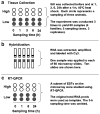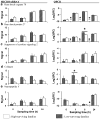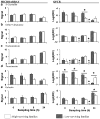Transcriptome profiling of selectively bred Pacific oyster Crassostrea gigas families that differ in tolerance of heat shock
- PMID: 19205802
- PMCID: PMC2882249
- DOI: 10.1007/s10126-009-9181-6
Transcriptome profiling of selectively bred Pacific oyster Crassostrea gigas families that differ in tolerance of heat shock
Abstract
Sessile inhabitants of marine intertidal environments commonly face heat stress, an important component of summer mortality syndrome in the Pacific oyster Crassostrea gigas. Marker-aided selection programs would be useful for developing oyster strains that resist summer mortality; however, there is currently a need to identify candidate genes associated with stress tolerance and to develop molecular markers associated with those genes. To identify candidate genes for further study, we used cDNA microarrays to test the hypothesis that oyster families that had high (>64%) or low (<29%) survival of heat shock (43 degrees C, 1 h) differ in their transcriptional responses to stress. Based upon data generated by the microarray and by real-time quantitative PCR, we found that transcription after heat shock increased for genes putatively encoding heat shock proteins and genes for proteins that synthesize lipids, protect against bacterial infection, and regulate spawning, whereas transcription decreased for genes for proteins that mobilize lipids and detoxify reactive oxygen species. RNAs putatively identified as heat shock protein 27, collagen, peroxinectin, S-crystallin, and two genes with no match in Genbank had higher transcript concentrations in low-surviving families than in high-surviving families, whereas concentration of putative cystatin B mRNA was greater in high-surviving families. These ESTs should be studied further for use in marker-aided selection programs. Low survival of heat shock could result from a complex interaction of cell damage, opportunistic infection, and metabolic exhaustion.
Figures





Similar articles
-
RNAi based transcriptome suggests genes potentially regulated by HSF1 in the Pacific oyster Crassostrea gigas under thermal stress.BMC Genomics. 2019 Aug 8;20(1):639. doi: 10.1186/s12864-019-6003-8. BMC Genomics. 2019. PMID: 31395030 Free PMC article.
-
Expression Characterization of Stress Genes Under High and Low Temperature Stresses in the Pacific Oyster, Crassostrea gigas.Mar Biotechnol (NY). 2016 Apr;18(2):176-88. doi: 10.1007/s10126-015-9678-0. Epub 2016 Jan 8. Mar Biotechnol (NY). 2016. PMID: 26746430
-
Identification of HSF1 Target Genes Involved in Thermal Stress in the Pacific Oyster Crassostrea gigas by ChIP-seq.Mar Biotechnol (NY). 2020 Apr;22(2):167-179. doi: 10.1007/s10126-019-09942-6. Epub 2020 Jan 21. Mar Biotechnol (NY). 2020. PMID: 31965439
-
The transcriptional response of the Pacific oyster Crassostrea gigas against acute heat stress.Fish Shellfish Immunol. 2017 Sep;68:132-143. doi: 10.1016/j.fsi.2017.07.016. Epub 2017 Jul 8. Fish Shellfish Immunol. 2017. PMID: 28698121
-
Role of hypoxia-inducible factor α in response to hypoxia and heat shock in the Pacific oyster Crassostrea gigas.Mar Biotechnol (NY). 2012 Feb;14(1):106-19. doi: 10.1007/s10126-011-9394-3. Epub 2011 Jul 6. Mar Biotechnol (NY). 2012. PMID: 21748344
Cited by
-
Comparative transcriptome analysis of Glyphodes pyloalis Walker (Lepidoptera: Pyralidae) reveals novel insights into heat stress tolerance in insects.BMC Genomics. 2017 Dec 19;18(1):974. doi: 10.1186/s12864-017-4355-5. BMC Genomics. 2017. PMID: 29258441 Free PMC article.
-
Microarray-based identification of gonad transcripts differentially expressed between lines of Pacific oyster selected to be resistant or susceptible to summer mortality.Mar Biotechnol (NY). 2010 Jun;12(3):326-39. doi: 10.1007/s10126-009-9227-9. Epub 2009 Oct 8. Mar Biotechnol (NY). 2010. PMID: 19813056
-
Contrasting impacts of ocean acidification and warming on the molecular responses of CO2-resilient oysters.BMC Genomics. 2017 Jun 2;18(1):431. doi: 10.1186/s12864-017-3818-z. BMC Genomics. 2017. PMID: 28578697 Free PMC article.
-
Application of genomic tools to study and potentially improve the upper thermal tolerance of farmed Atlantic salmon (Salmo salar).BMC Genomics. 2025 Mar 24;26(1):294. doi: 10.1186/s12864-025-11482-4. BMC Genomics. 2025. PMID: 40128646 Free PMC article.
-
RNAi based transcriptome suggests genes potentially regulated by HSF1 in the Pacific oyster Crassostrea gigas under thermal stress.BMC Genomics. 2019 Aug 8;20(1):639. doi: 10.1186/s12864-019-6003-8. BMC Genomics. 2019. PMID: 31395030 Free PMC article.
References
-
- Abele D, Heise K, Pörtner HO, Puntarulo S. Temperature-dependence of mitochondrial function and production of reactive oxygen species in the intertidal mud clam Mya arenaria. J Exp Biol. 2002;205:1831–1841. - PubMed
-
- Alexander WS. Suppressors of cytokine signaling (SOCS) in the immune system. Nat Rev Immunol. 2002;6:410–416. - PubMed
-
- Benjamini Y, Hochberg Y. Controling the false discovery rate: a practical and powerful approach to multiple testing. J R Statist Soc B. 1995;57:289–300.
-
- Bengoechea-Alsono M, Ericcson J. SREBP in signal transduction: cholesterol metabolism and beyond. Curr Op Cell Biol. 2007;19:215–222. - PubMed
Publication types
MeSH terms
Grants and funding
LinkOut - more resources
Full Text Sources
Molecular Biology Databases
Research Materials
